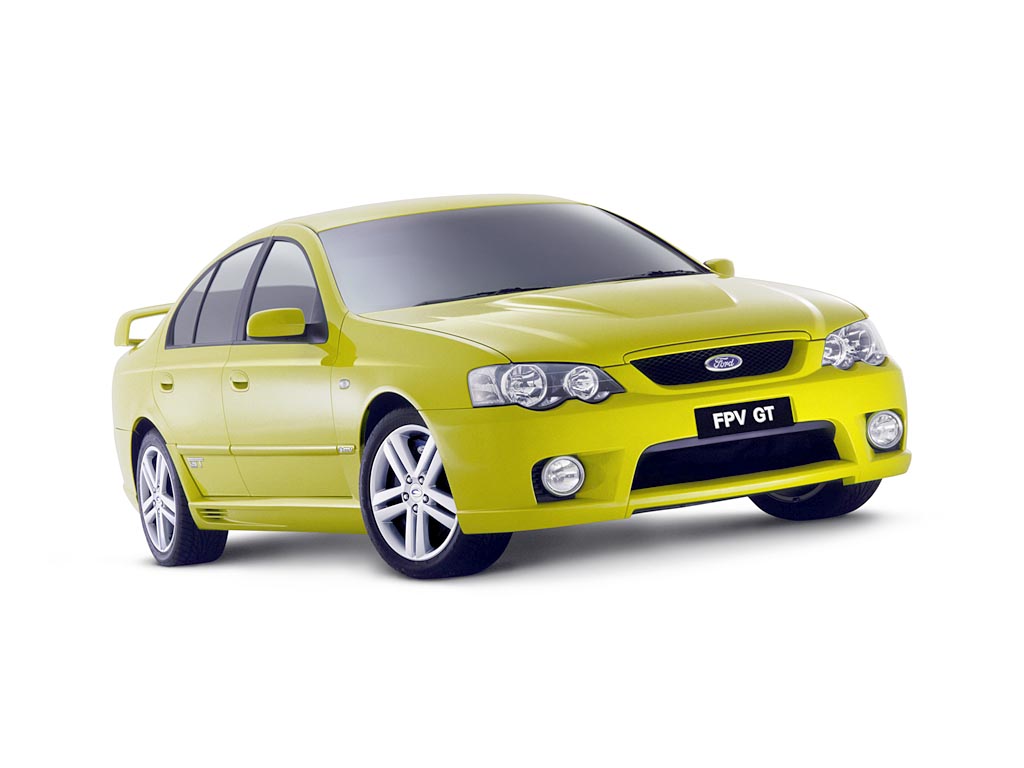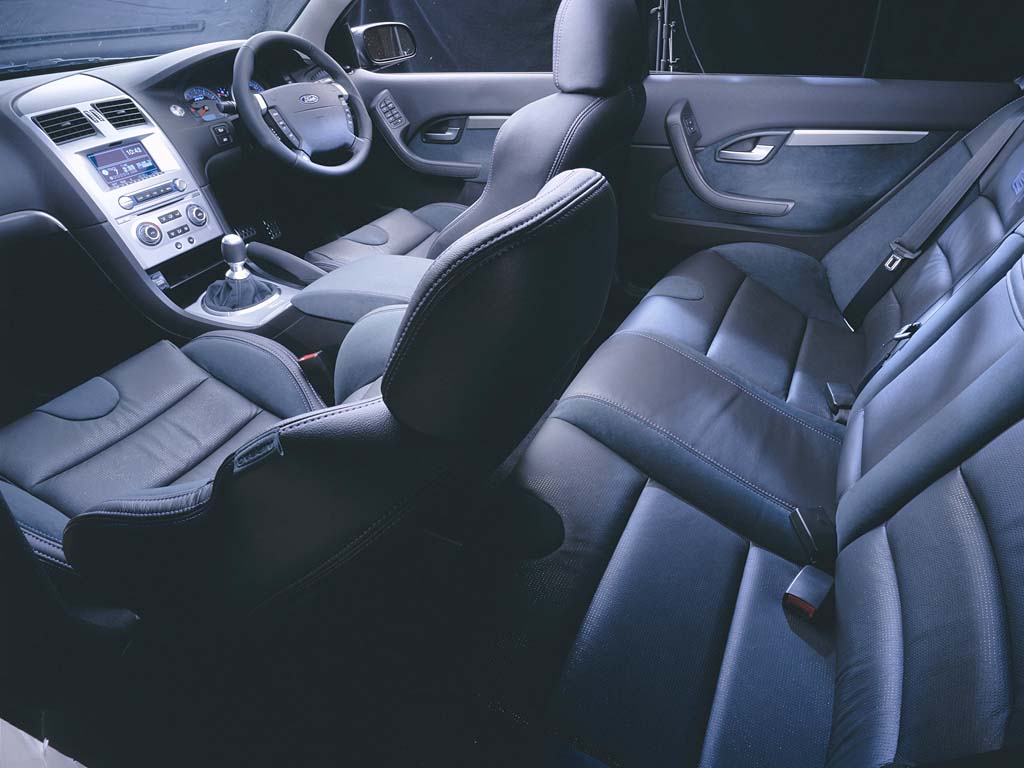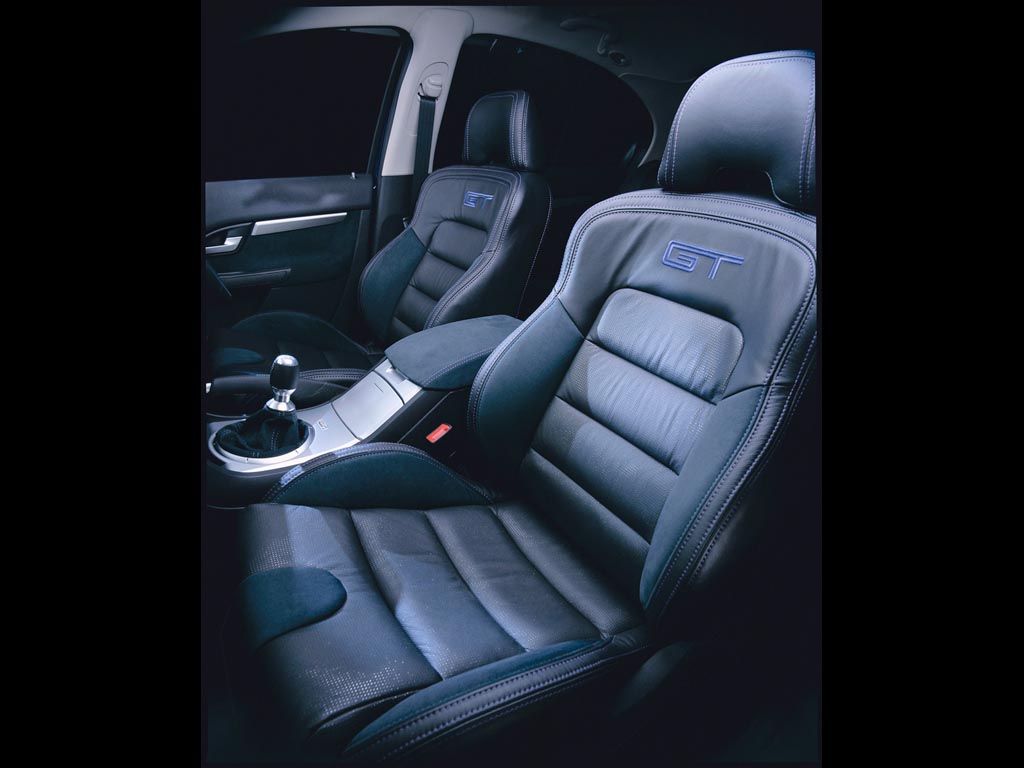2003 Ford Falcon GT
Based on the new BA Falcon, the GT will draw on a heritage dating back to the 1967 XR GT. The Falcon GT is the next step above the XR8 for the performance buyer who wants the definitive expression of Ford performance. It is a limited production Supercar made specifically for the Australian market.
A new BOSS 302
The first Boss 302 V8 engine was born in 1969 by combining the latest and proven cast-iron Windsor 302 block with the larger, deeper-breathing Cleveland heads to generate a new Mustang legend in Trans-Am racing. It was a legend that had an unforgettable Australian chapter starring Allan Moffat and his factory Trans-Am Mustang Boss 302.
The original Trans-Am race-bred Boss 302 featured an aluminium high-rise manifold, four barrel carburettor, 4-bolt centre main bearing caps, forged crankshaft and special pistons. It delivered 290 bhp@5800 rpm on a compression ratio of 10.5:1.
The 390hp version of the new Boss engine starts with the rigid cast-iron block and high torque of Ford’s proven 5.4-litre V8, with forged steel crankshaft and cross-bolted main bearing caps as manufactured by Ford in Windsor, Ontario. The block is from the same all new V8 engine family introduced across the Falcon range.
The very latest development of the Cobra R alloy cylinder heads, with twin overhead camshafts, four valves per cylinder and high performance alloy inlet manifold, are the 21st century equivalent of the Cleveland heads. They are added to the latest version of the 5.4-litre block to create a new Boss that is even more formidable than the original.
The new Boss 390hp@5500 rpm, the same icon power figure in kilowatts (290kw) as the brake horsepower figures for the original Mustang Boss 302 and the first Falcon GT 351 on their 1969 release. It also shares its 10.5:1 compression ratio with the original Boss 302 while the 520Nm@4500 rpm torque figure launches the new GT, GT-P and Pursuit ute into a class of their own.
Recognising the GT heritage
Butterworth said there was considerable pressure from Ford fans to revive signature design features of the original Falcon GTs. ‘ design of the GT had to recognise the rich heritage that comes with the GT brand, without compromising on the integrity of the design. If the signature design features of the early GTs were reduced to gimmicks that didn’t work, the design would lose its honesty.’
‘The power bulge in FPV bonnets is a modern interpretation of the shaker, and a functional element designed to meet the engineering needs of today’s Boss engine. The bulge is not dressed up because there is no functional reason to do that.’
‘The lights in the front spoiler are another example. When auxiliary lights were first fitted to a GT in 1968, they were a separate accessory item fitted as standard in the original Falcon grille to go with the GT’s extra performance. The new lights have the detail of a traditional accessory auxiliary light. It looks as if they have been added later for high performance road use, which is exactly why we added them, Butterworth said.
It has a strong Ford DNA performance signature, with the trapezoidal grille at the top and the large inverted grille below it. We have achieved this through increasing the volume and widening the lower regions, which are actually much wider than other Falcon models.
Butterworth on the Exterior
‘Ford in the US had just revived the GT stripe on its new GT40 concept in a simple twin parallel stripe format with the model name in the graphics. We had already established that they suited the Ford Special Vehicles (FPV) GT perfectly. Sydney Motor Show feedback confirmed that the time was right for a revival of this iconic GT feature.’ says Ford Design Director, Simon Butterworth
‘The new stripes add a fun, performance element to the GT. They also make the car look meaner and more aggressive by adding a stronger horizontal aspect. The stripes extend around the front corners to the lower lights to continue this more aggressive stance. As with early GT models, owners can order their GT without the stripes, in which case we add a separate GT badge to the rear doors,’ Butterworth said.
‘To complement the race car appearance given by the stripes and the other performance elements of the concept car, we added an additional tri-slot intake in the front bumper splitter. Both the upper and lower grilles are filled with matt black mesh for a competition look. The lower mesh grille carries FPV lettering as a reminder of the GT’s performance engineering.’
‘At the rear, we added a stronger more structural look to the large rear spoiler by adding a centre support spar. The GT is a strong, powerful car and the rear spoiler now reinforces that impression,’ he said.
The GT is fitted with an enhanced version of the open five-spoke wheel design revealed on the Motor Show concept.
Transmission
The 290 kilowatts and 520 Newton metres of torque generated by the Boss 290 V8 engine place the Ford Performance Vehicles GT in rarified road-going performance company. It’s not surprising that FPV sought out a company with a history of building gearboxes for drag and track racing to source the manual transmission for the GT. The TR3650 is Tremec’s first gearbox designed for road cars from the ground-up and has been specifically retooled for the GT.
There wasn’t an automatic transmission in Australia that could take the Boss 290’s 520 Newton metres of torque. So FPV collaborated with local automatic transmission manufacturer BTR to build one that would cope with it along with Australia’s high ambient temperatures and heavy towing loads.
BTR’s M97-019 is the first automatic to offer a console-mounted sequential shift with full manual override in a premium V8 performance model in Australia. In manual override mode, it won’t change up, unless the driver wants it to.
Suspension
To fine-tune the GT’s suspension, Ford Performance Vehicles knew exactly the man to call: Ford V8 Supercar champion and Bathurst winner, John Bowe.
As a result of his painstaking testing, the work of FPV’s suspension engineers and the already highly effective BA Falcon chassis, the new Ford Performance Vehicles GT offers an unprecedented combination of high-performance handling and a startlingly compliant ride. It is a true Grand Tourer for the driver and passengers alike.
Ford Performance Vehicles’ engineers have tuned the front of the car’s handling with Performance independent double-wishbone suspension. The FPV GT has constant-rate front coil springs twice as stiff as the standard BA Falcon XT. Together, the more rigid platform, stiffer springs and a 24-millimetre anti-roll bar deliver firmer handling which is offset for ride comfort by more compliant damper tuning.
The new Control Blade independent rear suspension introduced with the BA Falcon sets a new benchmark for Australian premium performance cars. It is a genuine multi-link, independent rear suspension similar to that developed by Ford subsidiary Jaguar for its X-Type.
Brakes
Apart from possessing outstanding performance, the GT had to deliver it predictably and instill confidence in its driver. So when the FPV Boss 290 V8 engine set a new benchmark combination of power and torque, it required a similar advance in braking. FPV offers two specification levels on the GT: the standard Performance brakes package or the optional Brembos.
Conclusion
The GT will lives up to the GT legend by combining exceptional power with total handling, an exceptional safety package, and aggressive aesthetics.
GT represents a performance sports car that goes beyond the standard Australian-built sports car. Its aggressive looks and powerful engine will be balanced by developments to the chassis, improvements to the driveline, and bigger brakes. The combination of all these elements will give the driver a true sense of what high-performance cars are all about – power, handling, braking, looks, masculinity, and status.
Story by Ford Performance Vehicles Pty Ltd, edited by Supercars.net
2003 Ford Falcon GT Gallery
In Detail
| submitted by | Richard Owen |
| engine | Boss 290 V8 |
| position | Front Longitudinal |
| aspiration | Natural |
| valvetrain | Chain Driven DOHC, 4 Valves per Cyl |
| displacement | 5408 cc / 330.0 in³ |
| bore | 90.2 mm / 3.55 in |
| stroke | 105.8 mm / 4.17 in |
| compression | 10.5:1 |
| power | 290 kw / 388.9 bhp @ 5500 rpm |
| specific output | 71.91 bhp per litre |
| torque | 520 nm / 383.5 ft lbs @ 4500 rpm |
| driven wheels | RWD |
| front tires | 245/40 ZR18 Dunlop SP9000 |
| rear tires | 245/40 ZR18 Dunlop SP9000 |
| front brakes | Cross Drilled Brembro Discs w/4-Piston Calipers w/ABS & Electronic Brake force Distribution (EBD) |
| f brake size | x 355 mm / x 14.0 in |
| rear brakes | Cross Drilled Brembro Discs w/4-Piston Calipers w/ABS & Electronic Brake force Distribution (EBD) |
| r brake size | x 330 mm / x 13.0 in |
| front wheels | F 45.7 x 20.3 cm / 18.0 x 8 in |
| rear wheels | R 45.7 x 20.3 cm / 18 x 8 in |
| f suspension | Wishbones w/Coil Springs, Anti-Roll Bar |
| r suspension | Control Blade w/Anti-Roll Bar |
| transmission | Tremec TR3650 5-Speed Manual or BTR 4-Speed Auto w/Sequential Shifting |
| gear ratios | :1 |
| final drive | 3.23:1 |















